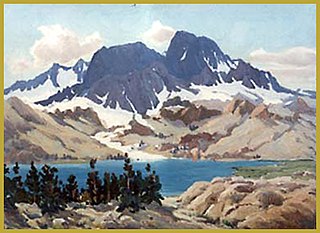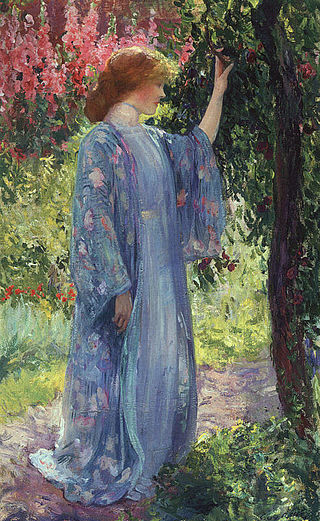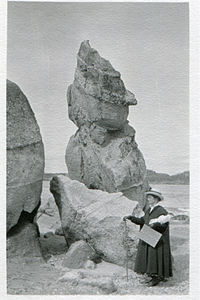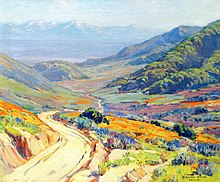
American Impressionism was a style of painting related to European Impressionism and practiced by American artists in the United States from the mid-nineteenth century through the beginning of the twentieth. The style is characterized by loose brushwork and vivid colors with a wide array of subject matters but focusing on landscapes and upper-class domestic life.

William Wendt was a German-born American landscape painter. He was called the "Dean of Southern California landscape painters." Associated with the Eucalyptus School, his work is more closely aligned with the Arts and Crafts Movement in California than the French or American Impressionists.

Joseph Kleitsch was a Hungarian-American portrait and plein air painter who holds a high place in the early California School of Impressionism.

Maurice Braun (1877–1941) was an American artist who became known for his Impressionist landscapes of southern California. He was born in Hungary on October 1, 1877; however, by the age of four, young Maurice and the Braun family had migrated to United States, and settled in New York City. His professional studies took him to the National Academy of Design, where he studied the French tradition under Francis C. Jones, George W. Maynard and Edgar M. Ward.
Arthur Hill Gilbert was an American Impressionist painter, notable as one of the practitioners of the California-style. Today, he is remembered for his large, colorful canvases depicting meadows and groves of trees along the state's famed 17 Mile Drive. Gilbert was part of the group of American impressionist artists who lived and painted in the artists' colony scene in California at Carmel and Laguna Beach during the 1920s and 1930s.
The California Art Club (CAC) is one of the oldest and most active arts organizations in California. Founded in December 1909, it celebrated its centennial in 2009 and into the spring of 2010. The California Art Club originally evolved out of The Painters Club of Los Angeles, a short-lived group that lasted from 1906–09. The new organization was more inclusive, as it accepted women, sculptors and out-of-state artists.

Theodore Nikolai Lukits was a Romanian American portrait and landscape painter. His initial fame came from his portraits of glamorous actresses of the silent film era, but since his death, his Asian-inspired works, figures drawn from Hispanic California and pastel landscapes have received greater attention.

Colin Campbell Cooper, Jr. was an American impressionist painter of architectural paintings, especially of skyscrapers in New York City, Philadelphia, and Chicago. An avid traveler, he was also known for his paintings of European and Asian landmarks, as well as natural landscapes, portraits, florals, and interiors. In addition to being a painter, he was also a teacher and writer. His first wife, Emma Lampert Cooper, was also a highly regarded painter.
Peter Seitz Adams is an American artist. His body of work focuses on landscapes and seascapes created en plein air in oil or pastel as well as enigmatic figure and still-life paintings. He is noted for his colorful, high-key palette and broad brushwork. Adams has held numerous solo and group exhibitions in galleries and museums, including throughout California, the Western United States, and on the East Coast in Philadelphia, Vermont, and New York. Adams is the longest serving President of the California Art Club and has served on its board of directors in Pasadena, California from 1993 to 2018. He is also a writer on subjects relating to historic artists for the California Art Club Newsletter, as well as for a number of the organization's exhibition catalogs.

Victor Stanley Matson (1895–1972) was an American artist representative of the California Plein-Air school of painting. He was active from the 1920s until his death. An active organizer for several Southern California arts organizations, he served as president of the historic California Art Club from 1961 to 1962. His work was widely exhibited with the Southland art clubs in an era when few galleries were interested in Plein-Air landscapes and he had a solo exhibition at Los Angeles City Hall in 1964.

Christian von Schneidau (1893–1976) was a well known California portrait painter who was recognized for his paintings of Hollywood stars and the Los Angeles elite. During the Roaring Twenties he painted Mary Pickford and other figures from the film industry as well as a number of outdoor figures done in the classic American Impressionist manner. Von Schneideau was born in Ljungby, Kalmar County, Sweden 1893, with the name Bror Christian Valdemar Von Schneidau, but went by the shortened Christian von Schneidau. In addition to his portraiture, von Schneidau was also a landscape painter and a private teacher who passed on the French principles of instruction, which he learned at the Art Institute of Chicago to his students. Von Schneidau was also the founder of the Scandinavian-American Art Society in 1938 and served as its president for many years. He was also an active member of the California Art Club.
Tim Solliday is a contemporary California Plein-Air Painter and Western Artist who is known for his San Gabriel Valley landscapes and his paintings of American Indians and other western subjects. He studied with the California Impressionist portrait and landscape painter Theodore Lukits (1897–1992) in the 1970s and began working professionally in the early 1980s. Solliday is described as a painter with a "muscular, masculine style" and has been compared to artists of the Taos Ten, especially E. Martin Hennings. He is a Signature Member of the California Art Club. He exhibits with the Laguna Plein-Air Painters Association, the Oil Painters of America and at the Maynard Dixon Invitational, which is held in Utah each year. Solliday's work has been featured in a number of American art magazines such as Southwest Art, American Artist and Art of the West. Through his plein-air work in the pastel medium and large canvasses, he has played an important role in the revival of landscape painting in Southern California.
California Tonalism was art movement that existed in California from circa 1890 to 1920. Tonalist are usually intimate works, painted with a limited palette. Tonalist paintings are softly expressive, suggestive rather than detailed, often depicting the landscape at twilight or evening, when there is an absence of contrast. Tonalist paintings could also be figurative, but in them, the figure was usually out of doors or in an interior in a low-key setting with little detail.

Richard E. Miller was an American Impressionist painter and a member of the Giverny Colony of American Impressionists. Miller was primarily a figurative painter, known for his paintings of women posing languidly in interiors or outdoor settings. Miller grew up in St. Louis, studied in Paris, and then settled in Giverny. Upon his return to America, he settled briefly in Pasadena, California and then in the art colony of Provincetown, Massachusetts, where he remained for the rest of his life. Miller was a member of the National Academy of Design in New York and an award-winning painter in his era, honored in both France and Italy, and a winner of France's Legion of Honor. Over the past several decades, he has been the subject of a retrospective exhibition and his work has been reproduced extensively in exhibition catalogs and featured in a number of books on American Impressionism.

Decorative Impressionism is an art historical term that is credited to the art writer Christian Brinton, who first used it in 1911. Brinton titled an article on the American expatriate painter Frederick Carl Frieseke, one of the members of the famous Giverny Colony of American Impressionists, "The Decorative Impressionist."

Selden Connor Gile was an American painter who was mainly active in northern California between the early-1910s and the mid-1930s. He was the founder and leader of the Society of Six, a Bay Area group of artists known for their plein-air paintings and rich use of color, a quality that would later figure into the work of Bay Area figurative expressionists.
Karl Dempwolf is a contemporary California Plein-Air Painter who is known for his California Landscapes. He is a Signature Member of the California Art Club, and serves in its Advisory Board of Directors.
Jean Stern, Director Emeritus of The Irvine Museum is an art historian and retired museum director who specializes in paintings of the California Impressionist period (1890-1930).

Thomas Lorraine Hunt was a Canadian-American landscape painter of the 1920s and 30s, known especially for his dramatic use of color. His paintings are considered a transition from impressionism to modernism. His primary subjects were boats and harbors in which the colors and shapes on the canvas took precedence over the exactness of the objects. Hunt was active among the Southern California group of Impressionist plein air painters and a founding member of the Laguna Art Museum.
Clarence Keiser Hinkle was born in Auburn, California on June 19, 1880 and died July 21, 1960. Hinkle was an American painter and art educator. His art studio was in Laguna Beach, California and later in Santa Barbara, California.














